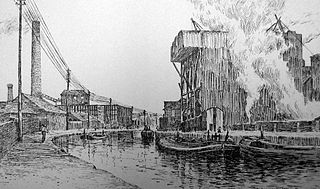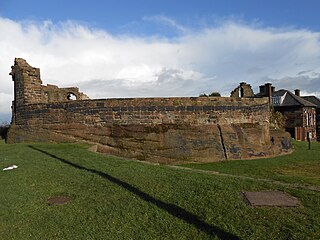Related Research Articles

Runcorn is an industrial town and cargo port in the Borough of Halton, Cheshire, England. Its population in 2021 was 62,100. Runcorn is on the southern bank of the River Mersey, where the estuary narrows to form the Runcorn Gap.

Henry, 3rd Earl of Leicester and Lancaster was a grandson of King Henry III of England (1216–1272) and was one of the principals behind the deposition of King Edward II (1307–1327), his first cousin.

de Lacy is the surname of an old Norman family which originated from Lassy, Calvados. The family took part in the Norman Conquest of England and the later Norman invasion of Ireland. The name is first recorded for Hugh de Lacy (1020–1085). His sons, Walter and Ilbert, left Normandy and travelled to England with William the Conqueror. The awards of land by the Conqueror to the de Lacy sons led to two distinct branches of the family: the northern branch, centred on Blackburnshire and west Yorkshire was held by Ilbert's descendants; the southern branch of Marcher Lords, centred on Herefordshire and Shropshire, was held by Walter's descendants.
The Abbey of St. Mary at Stanlaw, was a Cistercian foundation situated on Stanlaw - now Stanlow Point, on the banks of the River Mersey in the Wirral Peninsula, Cheshire, England, near Ellesmere Port, 11 km north of Chester Castle and 12 km south-west of Halton Castle.

Hazlehurst & Sons was a company making soap and alkali in Runcorn, Cheshire, England in the 19th century and in the early years of the 20th century. The family was also largely responsible for the growth of Methodism in the town during the 19th century.

The Barony of Halton, in Cheshire, England, comprised a succession of 15 barons and hereditary Constables of Chester under the overlordship of the Earl of Chester. It was not an English feudal barony granted by the king but a separate class of barony within the County Palatine of Chester.

Halton Castle is a castle in the village of Halton, part of the town of Runcorn, Cheshire, England. The castle is on the top of Halton Hill, a sandstone prominence overlooking the village. The original building, a motte-and-bailey castle began in 1071, was replaced with the current sandstone castle in the 13th century. Building alterations continued until at least 1609, when the structure is recorded as in disrepair. The castle is recorded in the National Heritage List for England as a designated Grade I listed building, and a scheduled ancient monument.

Runcorn is an industrial town in Halton, Cheshire, England, on the south bank of the River Mersey where it narrows at Runcorn Gap. In the town are the 61 buildings that are recorded in the National Heritage List for England as designated listed buildings in the current urban area of Runcorn, including the districts of Runcorn, Halton, Weston, Weston Point, and Norton. Two of these are classified as being in Grade I, nine in Grade II*, and 51 in Grade II.

Henry de Lacy, Earl of Lincoln, Baron of Pontefract, Lord of Bowland, Baron of Halton and hereditary Constable of Chester, was an English nobleman and confidant of King Edward I. He served Edward in Wales, France, and Scotland, both as a soldier and a diplomat. Through his mother he was a great-grandson of Amadeus IV, Count of Savoy. He is the addressee, or joint composer, of a poem by Walter of Bibbesworth about crusading, La pleinte par entre missire Henry de Lacy et sire Wauter de Bybelesworthe pur la croiserie en la terre seinte.

Roger de Lacy (1170–1211), Baron of Pontefract, Lord of Bowland, Lord of Blackburnshire, Baron of Halton, Constable of Chester, Sheriff of Yorkshire and Sheriff of Cumberland, also known as Roger le Constable, was a notable Anglo-Norman soldier, crusader and baron.

Rocksavage or Rock Savage was an Elizabethan mansion in Cheshire, England, which served as the primary seat of the Savage family. The house lies in ruins, at SJ526799 in Clifton. Built in the 1560s for Sir John Savage, Rocksavage was one of the great Elizabethan houses of the county, a leading example of the Elizabethan prodigy house; in 1674, it was the second largest house in Cheshire. James I visited in 1617. The house was abandoned after it passed into the Cholmondeley family early in the 18th century, and by 1782 only ruins remained.
Eustace fitz John, Constable of Chester, was a powerful magnate in northern England during the reigns of Henry I, Stephen and Henry II. From a relatively humble background in South East England, Eustace made his career serving Henry I, and was elevated by the king through marriage and office into one of the most important figures in the north of England. Eustace acquired a great deal of property in the region, controlled Bamburgh Castle, and served jointly with Walter Espec as justiciar of the North.
The timeline of Cheshire history shows significant events in the history of the English county of Cheshire.

Norton is an area in the eastern part of the town of Runcorn, Cheshire, England. It was originally a separate village 3 miles (5 km) to the east of Runcorn, but in the 1970s and 1980s became absorbed within Runcorn by the expansion of its new town.

John de Lacy, 2nd Earl of Lincoln was hereditary Constable of Chester, 7th Baron of Pontefract, 8th Baron of Halton and 8th Lord of Bowland.
Richard fitz Eustace was Constable of Chester and Baron of Halton within the County Palatine of Chester ruled by the Earl of Chester.
There are over 9,000 Grade I listed buildings and 20,000 Grade II* listed buildings in England. This page is a list of these buildings in the borough of Halton in Cheshire.

John fitz Richard was an Anglo-Norman soldier, Baron of Halton and hereditary Constable of Chester. Historical records refer to him as "John, Constable of Chester". He died at Acre in the Holy Land.

The Constable of Chester was a mediaeval hereditary office held by the Barons of Halton. The functions of the Constable are unclear, possibly they related to the custody of Chester Castle, as was the main function of most mediaeval constables, but Sanders (1960) says the office-holder was constable for the entire County Palatine.
References
- Nickson, Charles (1887), History of Runcorn, London and Warrington: Mackie & Co.
- Starkey, H. F. (1990), Old Runcorn, Halton: Halton Borough Council
- Whimperley, Arthur (1981), Halton Castle: An Introduction & Visitors' Handbook, Widnes: Arthur Whimperley
- Whimperley, Arthur (1986), The Barons of Halton, Widnes: MailBook Publishing